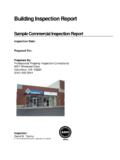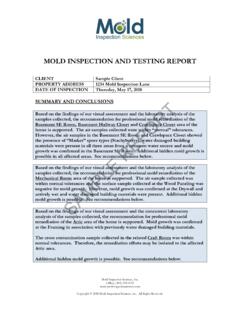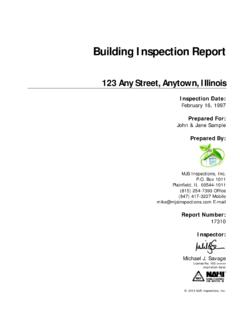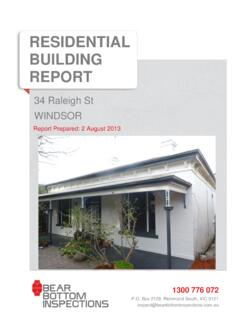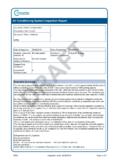Transcription of Dilapidation Inspection Report SAMPLE - Jim’s Building ...
1 Page 1. E. PL. Dilapidation Inspection Report Inspection Date: M. Property Address: SA. Page 2. Contents The parties Section A Results of Inspection - summary E. Section B General Section C Accessibility PL. Section D Significant items Section E Additional comments Section F Annexures to this Report Definitions to help you better understand this Report M. Terms on which this Report was prepared Special conditions or instructions SA. If you have any queries with this Report or require further information, please do not hesitate to contact the person who carried out the Inspection . This Report contains reference to material that is the copyright of Standards Australia. That content is reproduced under agreement with SAI Global to Jim's Building Inspections (Australia). Page 3. The Parties Name of Client: Name of Principal (if applicable): E.
2 Job Address: Client's Email Address: PL. Client's Phone Number: Consultant: George Vasilakis Ph: 0404 033 387. Email: Licence / Registration Number: INS HGL7525/HPI5139. M. Company Name: Jim's Building Inspections (Brighton). Company Address and Postcode: , Highett VIC 3190. SA. Company Email: Company Contact Numbers: 0404 033 387. Special conditions or instructions A Report may be conditional on information provided by the person, agents or employees of the person requesting the Report , apparent concealment of possible defects and a range of other factors. The following apply: Not Applicable Page 4. Section A Results of Inspection - summary A summary of your Inspection is outlined below; please also refer to the Report . Found Not Found E. Safety Hazard Major Defect PL. Minor Defect Additional specialist inspections: Not Applicable In summary the Building , compared to others of similar age and construction is in the condition M.
3 Documented in this Report . SA. Page 5. Section B General General description of the property Building Type: Commercial, Detached E. Number of Storeys: Single Main Building floor construction: Stumps, Strip Footings, Subfloor Timber Frame PL. Main Building wall construction: Brick Veneer (Timber Framed), Timber Framed and Clad Main Building roof construction: Pitched, Tiled Other timber Building elements: N/A. M. Other Building elements: Driveway, Fence - Brick Occupancy status: Occupied SA. Furnished: Furnished Strata or company title properties: No Orientation (to establish the way the property North was viewed): Prevailing weather conditions at the time of Fine Inspection : Page 6. Section C Accessibility Areas Inspected The following areas were inspected. As documented in your Pre- Inspection Agreement, obstructions and limitations to the accessible areas for Inspection are to be expected in any Inspection .
4 Refer also to our listing of obstructions and limitations. E. - Exterior - Interior - Fencing - Wall Exterior PL. The Inspection excludes areas which are affected by obstructions or where access is limited or unsafe. We do not move obstructions and Building defects may not be obvious unless obstructions or unsafe conditions are removed to provide access. The following areas were inaccessible: - Rooms where entry was denied to the inspector. M. Any areas which are inaccessible at the time of Inspection present a high risk for undetected Building defects. The client is strongly advised to make arrangements to access inaccessible areas urgently. Obstructions and Limitations Building defects may be concealed by the following obstructions which prevented full Inspection : - Stored items, built in cabinetry, furniture and personal items obscured approximately 25%.
5 SA. of every room. The presence of obstructions increases the risk of undetected defects. The client should make arrangement to remove obstructions where ever possible and re-inspect these areas as a matter of urgency. See also overall risk rating for undetected defects. Undetected defect risk assessment A risk rating is provided to help you understand the degree to which accessibility issues and the presence of obstructions have limited the scope of the Inspection . The risk of undetected defects is: Medium When the risk of undetected defects is high we strongly recommend further Inspection once access is provided or if the obstruction can be removed. Contact us for further advice. Page 7. Section D Significant Items Safety Hazard E. No evidence was found. Major Defect PL. No evidence was found.
6 Minor Defect Defects M. Building : Main Building Location: Entry Finding: Plaster - Cracking x2. Information: Cracking to the internal plaster was identified in this area at the time of Inspection . This cracking should be monitored frequently to identify whether further cracking results. SA. The plaster cracking is approximately up to 1mm wide by 250mm long at the time of Inspection . The plaster cracking is approximately up to 2mm wide by 400mm long at the time of Inspection . Page 8. Section D Significant Items E. PL. M. SA. Page 9. Defects Building : Main Building Location: Hallway Finding: Plaster - Cracking x3. Information: Cracking to the internal plaster was identified in this area at the time of Inspection . E. This cracking should be monitored frequently to identify whether further cracking results.
7 The plaster cracking is approximately up to 2mm wide by 60mm long at the time of Inspection . PL. The plaster cracking is approximately up to 2mm wide by 60mm long at the time of Inspection . The plaster cracking is approximately up to 2mm wide by 50mm long at the time of Inspection . M. SA. Page 10. Section D Significant Items Defects Building : Main Building Location: Kitchen Finding: Plaster - Cracking Information: Cracking to the internal plaster was identified in this area at the time of Inspection . E. This cracking should be monitored frequently to identify whether further cracking results. The plaster cracking is approximately up to 1mm wide by 300mm long at the time of Inspection . PL. M. SA. Page 11. Section D Significant Items E. Defects Building : Location: Main Building Reception Office PL.
8 M. Finding: Plaster - Cracking x3. Information: Cracking to the internal plaster was identified in this area at the time of Inspection . This cracking should be monitored frequently to identify whether further cracking results. The plaster cracking is approximately up to 1mm wide by 2500mm long at the time of Inspection . SA. The plaster cracking is approximately up to 2mm wide by 400mm long at the time of Inspection . The plaster cracking is approximately up to 1mm wide by 600mm long at the time of Inspection . Page 12. Section D Significant Items E. PL. M. SA. Page 13. Section D Significant Items Defects Building : Main Building Location: Waiting Room Finding: Plaster - Cracking x4. Information: Cracking to the internal plaster was identified in this area at the time of Inspection . E. This cracking should be monitored frequently to identify whether further cracking results.
9 The plaster cracking is approximately up to 1mm wide by 200mm long at the time of Inspection . PL. The plaster cracking is approximately up to 1mm wide by 600mm long at the time of Inspection . The plaster cracking is approximately up to 1mm wide by 700mm long at the time of Inspection . The plaster cracking is approximately up to 1mm wide by 400mm long at the time of Inspection . M. SA. Page 14. Section D Significant Items E. Defects Building : Location: Main Building Consulting Room 2 PL. M. Finding: Plaster - Cracking x3. Information: Cracking to the internal plaster was identified in this area at the time of Inspection . This cracking should be monitored frequently to identify whether further cracking results. The plaster cracking is approximately up to 1mm wide by 700mm long at the time of Inspection .
10 SA. The plaster cracking is approximately up to 2mm wide by 1200mm long at the time of Inspection . The plaster cracking is approximately up to 1mm wide by 400mm long at the time of Inspection . Page 15. Section D Significant Items E. PL. M. SA. Page 16. Defects Building : Main Building Location: Rear Elevation Finding: Brickwork - Sill Bricks Lifted/Mortar Cracking Information: Lifting of window sill bricks was identified in this area at the time of Inspection . E. This should be carefully monitored to ensure that further lifting does not ensue as a result of further Dilapidation . Sill bricks were raised by approximately 30mm. PL. Mortar to one brick was cracked. Please refer to associated photographs for further detail. M. SA. Page 17. Section D Significant Items E. Defects Building : Location: Main Building Front Elevation PL.
